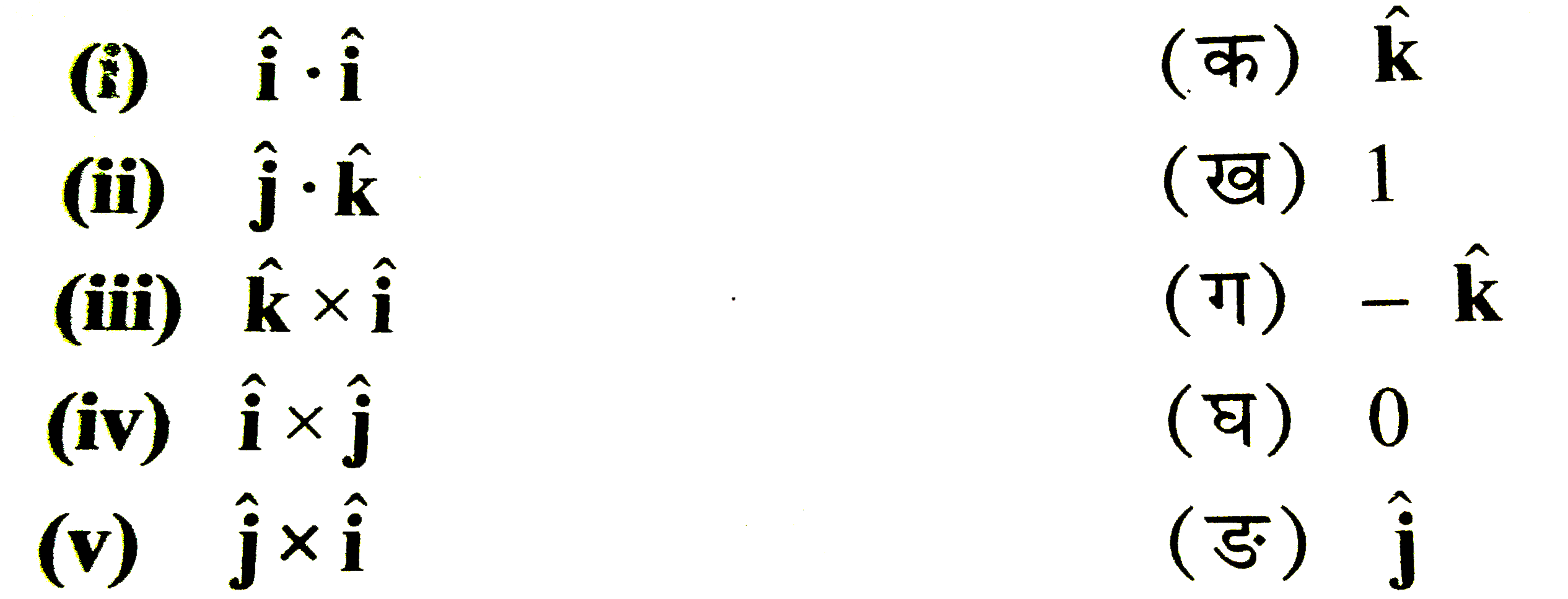सत्य
Topper's Solved these Questions
- समतल में गति Book:SHIVLAAL PUBLICATIONChapter:समतल में गति Exercise:प्रश्न (रिक्त स्थान की पूर्ति कीजिए - )
Explore 15 Videos
- समतल में गति Book:SHIVLAAL PUBLICATIONChapter:समतल में गति Exercise:प्रश्न (एक शब्द/वाक्य में उत्तर दीजिए -)
Explore 20 Videos
- समतल में गति Book:SHIVLAAL PUBLICATIONChapter:समतल में गति Exercise:प्रश्न (उचित जोड़ियाँ बनाइए - )
Explore 3 Videos
- वृत्तीय गति Book:SHIVLAAL PUBLICATIONChapter:वृत्तीय गति Exercise:वस्तुनिष्ठ प्रश्न
Explore 33 Videos
- सरल रेखा में गति Book:SHIVLAAL PUBLICATIONChapter:सरल रेखा में गति Exercise:वस्तुनिष्ठ प्रश्न
Explore 52 Videos
Similar Questions
क्षेत्रफल ………………… राशि है ।
View Solutionयदि →A=ˆi−ˆj+2ˆk तथा →B=3ˆi+2ˆj−ˆk हो तो →A.→B का मान क्या होगा ?
View Solutionसही जोड़ें

View Solutionएकसमान क्षैतिज वृत्तीय गति में नियत रहता है :
View Solutionगैस के अणुओं की गति होती है :
View SolutionIf →A=→b×→c[→b→c→c],→B=→c×→a[→c→a→b),→C=→a×→b[→a→b→c) find [→A→B→C]
View SolutionIf →a,→band→c are three vectors such that →a×→b=→c,→b×→c=→a,→c×→a=→b then prove that |→a|=∣∣→b∣∣=|→c|
View SolutionLet →a,→band→care vectors such that |→a|=3,∣∣→b∣∣=4and|→c|=5,and(→a+→b) is perpendicular to →c,(→b+→c) is perpendiculatr to →a and (→c+→a) is perpendicular to →b. Then find the value of ∣∣→a+→b+→c∣∣.
View SolutionIf →a,→band→c are three vectors such that →a×→b=→c,→b×→c=→a,→c×→a=→b then prove that |→a|=∣∣→b∣∣=|→c|
View SolutionLet →a,→b,→c be three vectors such that
→a⊥(→b+→c),→b⊥(→c+→a)and→c⊥(→a+→b), if |→a|=1,∣∣→b∣∣=2,
|→c|=3, then ∣∣→a+→b+→c∣∣ is,
View SolutionIf →a,→b,→c are vectors such that ∣∣→b∣∣=|→c| then {(→a+→b)×(→a+→c)}×(→b×→c).(→b+→c)=
View Solutionसिद्ध करें कि
(i) [→a+→b →b+→c →c+→a]=2[→a →b →c]
(ii) →a+→b,→b+→c और →c+→a असमतलीय होगें यदि →a,→b,→c तीन असमतलीय सदिश हों ।
View SolutionIf →a , →b , →c are three vectors, prove that [→a+→c,→a+→b,→a+→b+→c]=−[→a,→b,→c]
View SolutionLet →a,→b,→c be the three vectors such that →a.(→b+→c)+→b.(→c+→a)+→c.(→a+→b)=0and|→a|=1,∣∣→b∣∣=4,|→c|=8, then ∣∣→a+→b+→c∣∣ equals :
View Solution[→a+→b→b+→c→c+→a]=[→a→b→c], then
View SolutionIf →a,→b,→c are vectors such that ∣∣→b∣∣=|→c| then {(→a+→b)×(→a+→c)}×(→b×→c).(→b+→c)=
View Solution